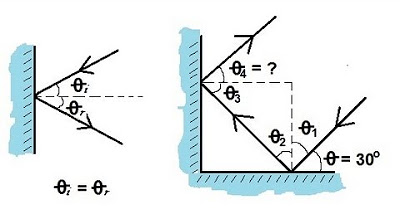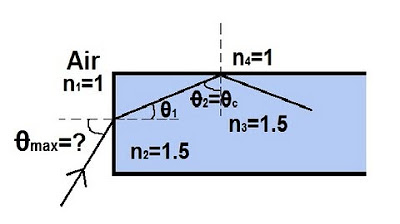Physics 51 - Optics: Reflections (2 of 2) Inbound and Exit Ray
TLDRThis lecture demonstrates the process of calculating the angle change of a light ray reflecting off two surfaces that are not at a right angle. It begins by illustrating the law of reflection for the first surface, establishing equal angles of incidence and reflection. The second reflection involves drawing a horizontal reference line to determine the angles of incidence and reflection for the second surface, which are found to be 50 degrees each. The total angle change is calculated by summing the individual angles, revealing that the exiting ray is 20 degrees away from being parallel to the inbound ray, providing a clear method to understand reflection in non-right angle scenarios.
Takeaways
- 🔍 The lecture discusses a method for calculating the angle between an inbound and an exiting ray after two reflections, which is not a simple corner reflector scenario.
- 📐 The first step is to identify the normal to the surface and the angle of incidence (theta sub one), which equals the angle of reflection (theta sub two) due to the law of reflection.
- 🔄 The inbound ray is reflected off the first surface, and the angle of incidence is equal to the angle of reflection, forming a 30-degree angle in this example.
- 📏 After the first reflection, the ray hits the second surface, and the angle of incidence (theta sub three) is calculated by considering the geometry of the situation.
- 📐 The angle of reflection off the second surface (theta sub four) is determined to be equal to theta sub three, which is 50 degrees, following the law of reflection.
- 📊 The total angle change for the ray after two reflections is calculated by adding the angles of incidence and reflection from both surfaces, summing up to 160 degrees.
- 📈 The final angle between the inbound and exiting ray is found by considering the parallel lines formed by extending the rays, which results in a 20-degree angle.
- 📝 The process involves drawing horizontal and perpendicular lines to establish reference points and angles, which are crucial for calculating the angles of incidence and reflection.
- 📈 The script uses the sum of interior angles of a triangle to deduce the unknown angles, applying geometric principles to the problem.
- 📚 The lecture demonstrates the importance of understanding geometric relationships and the law of reflection in optical problems.
- 🔎 The method can be applied to more complex optical systems where rays undergo multiple reflections, providing a systematic approach to solving such problems.
Q & A
What is the main topic of the lecture?
-The main topic of the lecture is the method of dealing with reflection in optics, specifically how to calculate the angle between an inbound ray and an exiting ray when reflecting off surfaces that are not at a 90-degree angle.
What is the significance of the normal in the first reflection?
-The normal is significant in the first reflection because it helps determine the angle of incidence (theta sub one), which is equal to the angle of reflection (theta sub two), according to the law of reflection.
Why is it necessary to draw a normal to the surface for the second reflection?
-Drawing a normal to the surface for the second reflection is necessary to determine the new angle of incidence (theta sub three) and the angle of reflection (theta sub four), which are crucial for calculating the final exiting angle of the ray.
What is the relationship between theta sub one and theta sub two?
-Theta sub one and theta sub two are related by the law of reflection, which states that the angle of incidence is equal to the angle of reflection, hence theta sub one equals theta sub two.
How is the angle of reflection for the second surface determined?
-The angle of reflection for the second surface is determined by using the horizontal line as a reference and recognizing that the sum of angles in a triangle must equal 180 degrees, leading to the conclusion that theta sub three and theta sub four are both 50 degrees.
What is the total sum of the angles involved in the reflection process?
-The total sum of the angles involved in the reflection process is 160 degrees, which includes theta sub one (30 degrees), theta sub two (30 degrees), theta sub three (50 degrees), and theta sub four (50 degrees).
Why are the two lines that extend from the points of reflection parallel to each other?
-The two lines are parallel because the sum of the angles on one side of the ray equals 180 degrees, indicating that the lines are extended in the same direction, making them parallel.
What is the angle between the inbound and exiting ray after all reflections?
-The angle between the inbound and exiting ray after all reflections is 20 degrees, which is calculated by subtracting the total sum of the angles (160 degrees) from 180 degrees.
How does the讲师 use the concept of a triangle to find theta sub three?
-The lecturer uses the concept of a triangle by recognizing that the sum of angles in a triangle is 180 degrees. By knowing one angle is 60 degrees and another is 30 degrees, the讲师 deduces that the remaining angle must be 90 degrees minus 30 degrees, which is 60 degrees, and then further calculates theta sub three to be 50 degrees.
What is the significance of the 20-degree angle mentioned at the end of the script?
-The 20-degree angle mentioned at the end of the script is the angle between the two lines that would be parallel if extended, indicating the final angle between the inbound and exiting rays after all reflections.
Outlines
🔍 Understanding Non-Right Angle Reflections
This paragraph discusses a complex reflection scenario involving an inbound ray and a surface that is not at a right angle. The lecturer introduces the concept of normal lines and the angles of incidence and reflection, emphasizing the equality of these angles. The explanation involves calculating the angles at each reflection point, using geometric principles to deduce the final angle between the inbound and exiting rays. The process includes identifying a 30-degree angle at the first reflection, drawing a horizontal reference line, and using it to determine subsequent angles, concluding with the calculation of the total angle change and the final angle between the two rays, which is 20 degrees.
Mindmap
Keywords
💡Reflection
💡Normal
💡Angle of Incidence
💡Angle of Reflection
💡Inbound Ray
💡Exiting Ray
💡Theta Subscripts
💡Law of Reflection
💡Perpendicular
💡Parallel Lines
💡Geometry
Highlights
Introduction to dealing with reflection in a more complex scenario that is not a corner reflector.
Explanation of the first reflection and the importance of the normal to the surface.
Identification of theta sub one as the angle of incidence equaling the angle of reflection.
Calculation of theta sub two as the angle of reflection, given a 60-degree angle.
Introduction of the second reflection and drawing a normal to the surface.
Determination of theta sub three and theta sub four as the angles of incidence and reflection for the second reflection.
Use of a horizontal reference line to help determine the angles involved in the second reflection.
Calculation of the 60-degree angle in the triangle formed by the reflected ray and the normal.
Determination that theta sub three is 50 degrees based on the angles included by the lines.
Confirmation that theta sub four is also 50 degrees due to the law of reflection.
Explanation of how the total angle change is calculated by adding the angles of reflection.
Conclusion that the total angle sum is 160 degrees, indicating the rays are not parallel.
Final calculation showing the angle between the inbound and exit ray is 20 degrees.
Demonstration of the method to calculate the angle change in a non-right angle reflection scenario.
Transcripts
Browse More Related Video
5.0 / 5 (0 votes)
Thanks for rating:





